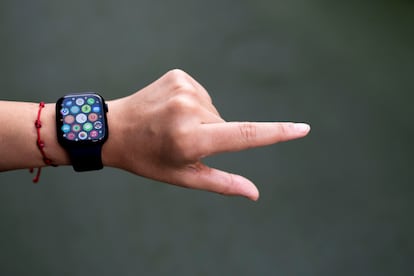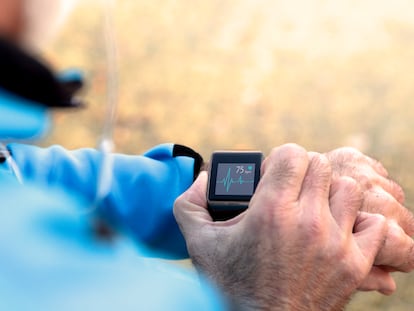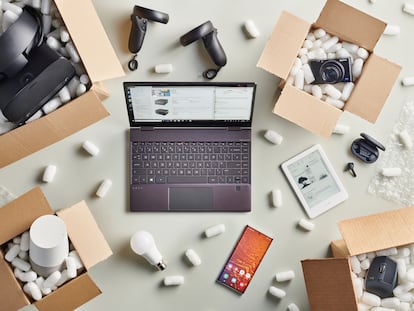This is how double tap on the Apple Watch Series 9 works, and this is what it will do in the future
The new feature allows you to control applications with a simple gesture of your fingers in the air, opening up multiple possibilities regarding how to use your device

The internet is filling up with videos of users of the new Apple Watch Series 9. They pinch the air with their fingers to control the newly-released smartwatch, without putting a single finger on its screen.
For those who don’t know or haven’t seen it yet (see the video below), while wearing your watch, just bring your index and thumb together twice. This will allow the watch to recognize the command to open or close an app. Several users have been able to try this feature out already, thanks to the latest watchOS update — 10.1 — the final version of which is expected to be available throughout the month of October.
What exactly is this feature for? Well, the truth is that it doesn’t have a specific function — double tap simply relates to the app that’s running at the moment on your watch, allowing you to control its main button. For instance, if someone calls you, you can double-tap to answer, and if you’re done with your call, you can double-tap to hang up. Similarly, if the watch’s camera icon is open, it will take a photo if you double-tap. There’s an endless variety of examples: you can stop a timer, play, or pause a song, silence an alarm, or even respond to a message with your voice.
This technology is possible thanks to the Apple Neural Engine that has been incorporated into the latest Apple Watch. It’s an extra processor that’s responsible for tasks related to artificial intelligence and machine learning. It can detect — through the accelerometer, gyroscope and optical heart rate sensor — the small movements and changes in blood circulation that occur when one performs the double tap gesture.
Is this only for the Series 9?
The question inevitably arises: will users of previous versions of Apple’s smart watch be able to enjoy this feature? The answer is no. It’s only available on the Apple Watch Series 9 and the Apple Watch Ultra 2, and only so long as the watchOS 10.1 update that we talked about at the beginning of this article is installed.
One thing to keep in mind is that double tap is disabled by default. It’s activated from the device itself or from the iPhone Watch app — it involves giving the system permission to deactivate certain accessibility options that may interfere with it. In fact, enabling double tap disables a very similar feature that previous Apple Watch models have, although many users aren’t even aware of it: Hand Gestures. This set of gestures is hidden among the accessibility options of the Apple Watch (inside of the AssistiveTouch function). They actually work in a very similar manner to double tap. The same pinch gesture moves you to the next menu item, while a double pinch takes you back. If you close your hand into a fist, you select an item… and, if you do it twice, it opens the actions menu, which allows you to scroll through the screen. Compatible with the Apple Watch Series 4, the first-generation Apple Watch SE and the Apple Watch Ultra, it’s especially interesting that these gestures can be customized, so that the user can decide what each one does.
What’s the future of double tap?
The idea of Apple engineers is to continue developing this function, both in terms of double tap and the rest of the control options that, until now, were in the accessibility section. This was already foreseen in a paper published in April 2022 titled Enabling Hand Gesture Customization on Wrist-Worn Devices. In this document, the engineers were already discussing a combination of gyroscopes, accelerometers and skin-reading factors to determine what users would be asking the devices to do via hand movements.
According to the engineers, there are a total of 12 gestures that must be fully-customizable. “To truly leverage gestural input, devices should allow users to add their own gestures beyond a pre-existing gesture vocabulary. This unlocks several advantages, including better gesture memorability, higher interaction efficiency and enhanced accessibility for people with special needs,” they stated in the document. To enjoy these features, however, we still have to wait.
Sign up for our weekly newsletter to get more English-language news coverage from EL PAÍS USA Edition
Tu suscripción se está usando en otro dispositivo
¿Quieres añadir otro usuario a tu suscripción?
Si continúas leyendo en este dispositivo, no se podrá leer en el otro.
FlechaTu suscripción se está usando en otro dispositivo y solo puedes acceder a EL PAÍS desde un dispositivo a la vez.
Si quieres compartir tu cuenta, cambia tu suscripción a la modalidad Premium, así podrás añadir otro usuario. Cada uno accederá con su propia cuenta de email, lo que os permitirá personalizar vuestra experiencia en EL PAÍS.
¿Tienes una suscripción de empresa? Accede aquí para contratar más cuentas.
En el caso de no saber quién está usando tu cuenta, te recomendamos cambiar tu contraseña aquí.
Si decides continuar compartiendo tu cuenta, este mensaje se mostrará en tu dispositivo y en el de la otra persona que está usando tu cuenta de forma indefinida, afectando a tu experiencia de lectura. Puedes consultar aquí los términos y condiciones de la suscripción digital.
More information
Archived In
Últimas noticias
Emily Goligoski, researcher: ‘I have a policy for the use of devices in class. How can I compete against dopamine while teaching some theory?’
‘Sextette’: The story of Mae West’s final madcap movie
When Judas Priest were accused of inducing two fans to kill themselves: A chronicle of the most infamous trial in music history
North Korea, the latest stage in the Russian indoctrination of Ukrainian children
Most viewed
- The number of international tourists going to the US is decreasing, with one exception: Mexico
- A mountaineer, accused of manslaughter for the death of his partner during a climb: He silenced his phone and refused a helicopter rescue
- Belle da Costa, the woman who concealed her origins in 1905 and ended up running New York’s most legendary library
- Liset Menéndez de la Prida, neuroscientist: ‘It’s not normal to constantly seek pleasure; it’s important to be bored, to be calm’
- An interstellar traveler is getting closer to Earth than ever before: How to observe comet 3I/ATLAS











































